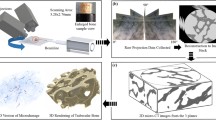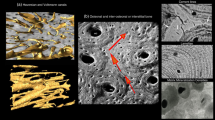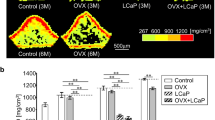Abstract
Summary
We analyzed morphological characteristics of osteons along with the geometrical indices of individual osteonal mechanical stability in young, healthy aged, untreated osteoporotic, and bisphosphonate-treated osteoporotic women. Our study revealed significant intergroup differences in osteonal morphology and osteocyte lacunae indicating different remodeling patterns with implications for fracture susceptibility.
Introduction
Bone remodeling is the key process in bone structural reorganization, and its alterations lead to changes in bone mechanical strength. Since osteons reflect different bone remodeling patterns, we hypothesize that the femoral cortices of females under miscellaneous age, disease and treatment conditions will display distinct osteonal morphology and osteocyte lacunar numbers along with different mechanical properties.
Methods
The specimens used in this study were collected at autopsy from 35 female donors (young group, n = 6, age 32 ± 8 years; aged group, n = 10, age 79 ± 9 years; osteoporosis group, n = 10, age 81 ± 9 years; and bisphosphonate group, n = 9, age 81 ± 7 years). Von Kossa-modified stained femoral proximal diaphyseal sections were evaluated for osteonal morphometric parameters and osteocyte lacunar data. Geometrical indices of osteonal cross-sections were calculated to assess the mechanical stability of individual osteons, in terms of their resistance to compression, bending, and buckling.
Results
The morphological assessment of osteons and quantification of their osteocyte lacunae revealed significant differences between the young, aged, osteoporosis and bisphosphonate-treated groups. Calculated osteonal geometric indices provided estimates of the individual osteons’ resistance to compression, bending and buckling based on their size. In particular, the osteons in the bisphosphonate-treated group presented improved osteonal geometry along with increased numbers of osteocyte lacunae that had been formerly impaired due to aging and osteoporosis.
Conclusions
The data derived from osteons (as the basic structural units of the cortical bone) in different skeletal conditions can be employed to highlight structural factors contributing to the fracture susceptibility of various groups of individuals.



Similar content being viewed by others
Notes
A limitation of this framework is the fact that the osteons are embedded in the bone matrix and fully surrounded by interstitial bone and other osteons; thus, the osteons in bone should be considered as an element in a complex composite [29], where the mechanical properties are influenced not only by the properties of the osteon but also by the surrounding matrix [30]. Further studies are required to quantify the distribution of osteons in the matrix to better understand the contributions of the interstitial bone.
References
Cooper C, Campion G, Melton LJ (1992) Hip fractures in the elderly: a world-wide projection. Osteoporos Int 2:285–289
Cole Z, Dennison E, Cooper C (2008) Osteoporosis epidemiology update. Curr Rheum Rep 10:92–96
Burge R, Dawson-Hughes B, Solomon DH, Wong JB, King A, Tosteson A (2007) Incidence and economic burden of osteoporosis-related fractures in the United States, 2005–2025. J Bone Miner Res 22:465–475
Milovanovic P, Djonic D, Marshall RP, Hahn M, Nikolic S, Zivkovic V, Amling M, Djuric M (2012) Micro-structural basis for particular vulnerability of the superolateral neck trabecular bone in the postmenopausal women with hip fractures. Bone 50:63–68
Mayhew PM, Thomas CD, Clement JG, Loveridge N, Beck TJ, Bonfield W, Burgoyne CJ, Reeve J (2005) Relation between age, femoral neck cortical stability, and hip fracture risk. Lancet 366:129–135
Busse B, Hahn M, Schinke T, Püschel K, Duda GN, Amling M (2010) Reorganization of the femoral cortex due to age-, sex-, and endoprosthetic-related effects emphasized by osteonal dimensions and remodeling. J Biomed Mater Res A 92A:1440–1451
Currey JD (2002) Bones: structure and mechanics. Princeton University Press, Princeton
Skedros JG, Clark GC, Sorenson SM, Taylor KW, Qiu S (2011) Analysis of the effect of osteon diameter on the potential relationship of osteocyte lacuna density and osteon wall thickness. Anat Rec A 294:1472–1485
Rauch F, Travers R, Glorieux FH (2007) Intracortical remodeling during human bone development—a histomorphometric study. Bone 40:274–280
Metz LN, Martin RB, Turner AS (2003) Histomorphometric analysis of the effects of osteocyte density on osteonal morphology and remodeling. Bone 33:753–759
Thomas CDL, Stein MS, Feik SA, Wark JD, Clement JG (2000) Determination of age at death using combined morphology and histology of the femur. J Anat 196:463–471
Ascenzi M-G, Liao VP, Lee BM, Billi F, Zhou H, Lindsay R, Cosman F, Nieves J, Bilezikian JP, Dempster DW (2012) Parathyroid hormone treatment improves the cortical bone microstructure by improving the distribution of type I collagen in postmenopausal women with osteoporosis. J Bone Miner Res 27:702–712
Britz HM, Thomas CDL, Clement JG, Cooper DML (2009) The relation of femoral osteon geometry to age, sex, height and weight. Bone 45:77–83
Barth RW, Williams JL, Kaplan FS (1992) Osteon morphometry in females with femoral neck fractures. Clin Orthop Relat Res 283:178–186
Beck TJ, Looker AC, Ruff CB, Sievanen H, Wahner HW (2000) Structural trends in the aging femoral neck and proximal shaft: analysis of the Third National Health and Nutrition Examination Survey dual-energy X-ray absorptiometry data. J Bone Miner Res 15:2297–2304
Beck TJ, Ruff CB, Warden KE, Scott WW Jr, Rao GU (1990) Predicting femoral neck strength from bone mineral data. A structural approach. Invest Radiol 25:6–18
Seeman E (2008) Structural basis of growth-related gain and age-related loss of bone strength. Rheumatology 47:iv2–iv8
Marotti G (1996) The structure of bone tissues and the cellular control of their deposition. Ital J Anat Embryol 101:25–79
Power J, Doube M, van Bezooijen RL, Loveridge N, Reeve J (2012) Osteocyte recruitment declines as the osteon fills in: interacting effects of osteocytic sclerostin and previous hip fracture on the size of cortical canals in the femoral neck. Bone 50:1107–1114
Qiu S, Rao DS, Palnitkar S, Parfitt AM (2010) Dependence of bone yield (volume of bone formed per unit of cement surface area) on resorption cavity size during osteonal remodeling in human rib: implications for osteoblast function and the pathogenesis of age-related bone loss. J Bone Miner Res 25:423–430
Skedros JG, Kiser CJ, Keenan KE, Thomas SC (2011) Analysis of osteon morphotype scoring schemes for interpreting load history: evaluation in the chimpanzee femur. J Anat 218:480–499
Hahn M, Vogel M, Delling G (1991) Undecalcified preparation of bone tissue: report of technical experience and development of new methods. Virchows Arch A Pathol Anat Histopathol 418:1–7
Donath K, Breuner G (1982) A method for the study of undecalcified bones and teeth with attached soft tissues. The Säge–Schliff (sawing and grinding) technique. J Oral Pathol 11:318–326
Busse B, Djonic D, Milovanovic P, Hahn M, Püschel K, Ritchie RO, Djuric M, Amling M (2010) Decrease in the osteocyte lacunar density accompanied by hypermineralized lacunar occlusion reveals failure and delay of remodeling in aged human bone. Aging Cell 9:1065–1075
Bell KL, Loveridge N, Jordan GR, Power J, Constant CR, Reeve J (2000) A novel mechanism for induction of increased cortical porosity in cases of intracapsular hip fracture. Bone 27:297–304
Jordan GR, Loveridge N, Bell KL, Power J, Rushton N, Reeve J (2000) Spatial clustering of remodeling osteons in the femoral neck cortex: a cause of weakness in hip fracture? Bone 26:305–313
Dempster DW, Compston JE, Drezner MK, Glorieux FH, Kanis JA, Malluche H, Meunier PJ, Ott SM, Recker RR, Parfitt AM (2013) Standardized nomenclature, symbols, and units for bone histomorphometry: a 2012 update of the report of the ASBMR Histomorphometry Nomenclature Committee. J Bone Miner Res 28:2–17
Currey J (2012) The structure and mechanics of bone. J Mater Sci 47:41–54
Guo XE, Liang LC, Goldstein SA (1998) Micromechanics of osteonal cortical bone fracture. J Biomech Eng 120:112–117
Bigley RF, Griffin LV, Christensen L, Vandenbosch R (2006) Osteon interfacial strength and histomorphometry of equine cortical bone. J Biomech 39:1629–1640
Chavassieux PM, Arlot ME, Reda C, Wei L, Yates AJ, Meunier PJ (1997) Histomorphometric assessment of the long-term effects of alendronate on bone quality and remodeling in patients with osteoporosis. J Clin Invest 100:1475–1480
Burr DB, Diab T, Koivunemi A, Koivunemi M, Allen MR (2009) Effects of 1 to 3 years' treatment with alendronate on mechanical properties of the femoral shaft in a canine model: implications for subtrochanteric femoral fracture risk. J Orthop Res 27:1288–1292
Faingold A, Cohen SR, Wagner HD (2012) Nanoindentation of osteonal bone lamellae. J Mech Behav Biomed Mater 9:198–206
Wu Y, Bergot C, Jolivet E, Zhou LQ, Laredo J-D, Bousson V (2009) Cortical bone mineralization differences between hip-fractured females and controls. A microradiographic study. Bone 45:207–212
Bergot C, Wu Y, Jolivet E, Zhou LQ, Laredo JD, Bousson V (2009) The degree and distribution of cortical bone mineralization in the human femoral shaft change with age and sex in a microradiographic study. Bone 45:435–442
Bala Y, Depalle B, Douillard T, Meille S, Clément P, Follet H, Chevalier J, Boivin G (2011) Respective roles of organic and mineral components of human cortical bone matrix in micromechanical behavior: an instrumented indentation study. J Mech Behav Biomed Mater 4:1473–1482
Giraud-Guille MM (1988) Twisted plywood architecture of collagen fibrils in human compact bone osteons. Calcif Tissue Int 42:167–180
Ascenzi A, Bonucci E (1968) The compressive properties of single osteons. Anat Rec 161:377–391
Gamsjaeger S, Buchinger B, Zwettler E, Recker R, Black D, Gasser JA, Eriksen EF, Klaushofer K, Paschalis EP (2011) Bone material properties in actively bone-forming trabeculae in postmenopausal women with osteoporosis after three years of treatment with once-yearly Zoledronic acid. J Bone Miner Res 26:12–18
Bala Y, Depalle B, Farlay D, Douillard T, Meille S, Follet H, Chapurlat R, Chevalier J, Boivin G (2012) Bone micromechanical properties are compromised during long-term alendronate therapy independently of mineralization. J Bone Miner Res 27:825–834
Hazenberg J, Taylor D, Lee T (2007) The role of osteocytes and bone microstructure in preventing osteoporotic fractures. Osteoporos Int 18:1–8
Zimmermann EA, Schaible E, Bale H, Barth HD, Tang SY, Reichert P, Busse B, Alliston T, Ager JW, Ritchie RO (2011) Age-related changes in the plasticity and toughness of human cortical bone at multiple length scales. Proc Natl Acad Sci USA 108:14416–14421
Ritchie RO (2011) The conflicts between strength and toughness. Nat Mater 10:817–822
Barth HD, Zimmermann EA, Schaible E, Tang SY, Alliston T, Ritchie RO (2011) Characterization of the effects of X-ray irradiation on the hierarchical structure and mechanical properties of human cortical bone. Biomaterials 32:8892–8904
Burger EH, Klein-Nulend J (1999) Mechanotransduction in bone—role of the lacuno-canalicular network. FASEB J 13:101–112
Vashishth D, Verborgt O, Divine G, Schaffler MB, Fyhrie DP (2000) Decline in osteocyte lacunar density in human cortical bone is associated with accumulation of microcracks with age. Bone 26:375–380
Duque G, Troen BR (2008) Understanding the mechanisms of senile osteoporosis: new facts for a major geriatric syndrome. J Am Geriatr Soc 56:935–941
Russell RG (2011) Bisphosphonates: the first 40 years. Bone 49:2–19
Allen MR, Burr DB (2011) Bisphosphonate effects on bone turnover, microdamage, and mechanical properties: what we think we know and what we know that we don't know. Bone 49:56–65
Saag K, Lindsay R, Kriegman A, Beamer E, Zhou W (2007) A single zoledronic acid infusion reduces bone resorption markers more rapidly than weekly oral alendronate in postmenopausal women with low bone mineral density. Bone 40:1238–1243
Dempster DW, Zhou H, Recker RR, Brown JP, Bolognese MA, Recknor CP, Kendler DL, Lewiecki EM, Hanley DA, Rao DS, Miller PD, Woodson GC, Lindsay R, Binkley N, Wan X, Ruff VA, Janos B, Taylor KA (2012) Skeletal Histomorphometry in subjects on teriparatide or zoledronic acid therapy (SHOTZ) study: a randomized controlled trial. J Clin Endocrinol Metab 97:2799–2808
Black DM, Schwartz AV, Ensrud K, Cauley J, Levis S, Quandt SA, Satterfield S, Wallace RB, Bauer DC, Palermo L, Wehren LE, Lombardi A, Santora AC, Cummings SR (2006) Effects of continuing or stopping alendronate after 5 years of treatment: the fracture intervention trial long-term extension (flex): a randomized trial. J Am Med Assoc 296:2927–2938
McClung M, Recker R, Miller P, Fiske D, Minkoff J, Kriegman A, Zhou W, Adera M, Davis J (2007) Intravenous zoledronic acid 5 mg in the treatment of postmenopausal women with low bone density previously treated with alendronate. Bone 41:122–128
Devogelaer JP, Broll H, Correa-Rotter R, Cumming DC, Nagant de Deuxchaisnes C, Geusens P, Hosking D, Jaeger P, Kaufman JM, Leite M, Leon J, Liberman U, Menkes CJ, Meunier PJ, Reid I, Rodriguez J, Romanowicz A, Seeman E, Vermeulen A, Hirsch LJ, Lombardi A, Plezia K, Santora AC, Yates AJ, Yuan W (1996) Oral alendronate induces progressive increases in bone mass of the spine, hip, and total body over 3 years in postmenopausal women with osteoporosis. Bone 18:141–150
Bone HG, Hosking D, Devogelaer J-P, Tucci JR, Emkey RD, Tonino RP, Rodriguez-Portales JA, Downs RW, Gupta J, Santora AC, Liberman UA (2004) Ten years' experience with alendronate for osteoporosis in postmenopausal women. N Engl J Med 350:1189–1199
Martin RB (2000) Toward a unifying theory of bone remodeling. Bone 26:1–6
Qiu S, Rao DS, Palnitkar S, Parfitt AM (2002) Relationships between osteocyte density and bone formation rate in human cancellous bone. Bone 31:709–711
Pazzaglia UE, Congiu T, Franzetti E, Marchese M, Spagnuolo F, Di Mascio L, Zarattini G (2012) A model of osteoblast–osteocyte kinetics in the development of secondary osteons in rabbits. J Anat 220:372–383
Skedros JG, Keenan KE, Williams TJ, Kiser CJ (2013) Secondary osteon size and collagen/lamellar organization (“osteon morphotypes”) are not coupled, but potentially adapt independently for local strain mode or magnitude. J Struct Biol 181:95–107
Simões JA, Vaz MA, Blatcher S, Taylor M (2000) Influence of head constraint and muscle forces on the strain distribution within the intact femur. Med Eng Phys 22:453–459
Acknowledgments
Dr. Petar Milovanovic is a fellow of the DAAD (Deutscher Akademischer Austauschdienst—German Academic Exchange Service; A/11/83161) and Serbian Ministry of Science (III45005). Dr. Björn Busse is a fellow of the DFG—Emmy Noether program (Deutsche Forschungsgemeinschaft—German Research Foundation; BU 2562/2-1). This study was supported by grants from the South-Eastern-European-Cooperation, University Medical Center Hamburg-Eppendorf and from the Federal Ministry of Education and Research (BMBF) through the consortium “BioAssett” and “Osteopath.”
Conflicts of interest
None.
Author information
Authors and Affiliations
Corresponding author
Additional information
A. Bernhard and P. Milovanovic contributed equally and therefore share first authorship.
Rights and permissions
About this article
Cite this article
Bernhard, A., Milovanovic, P., Zimmermann, E.A. et al. Micro-morphological properties of osteons reveal changes in cortical bone stability during aging, osteoporosis, and bisphosphonate treatment in women. Osteoporos Int 24, 2671–2680 (2013). https://doi.org/10.1007/s00198-013-2374-x
Received:
Accepted:
Published:
Issue Date:
DOI: https://doi.org/10.1007/s00198-013-2374-x




